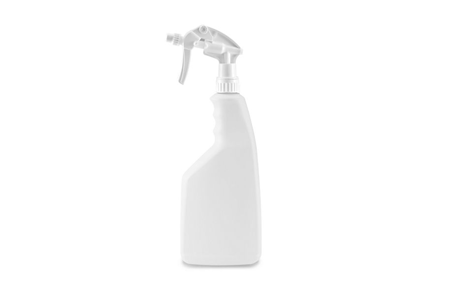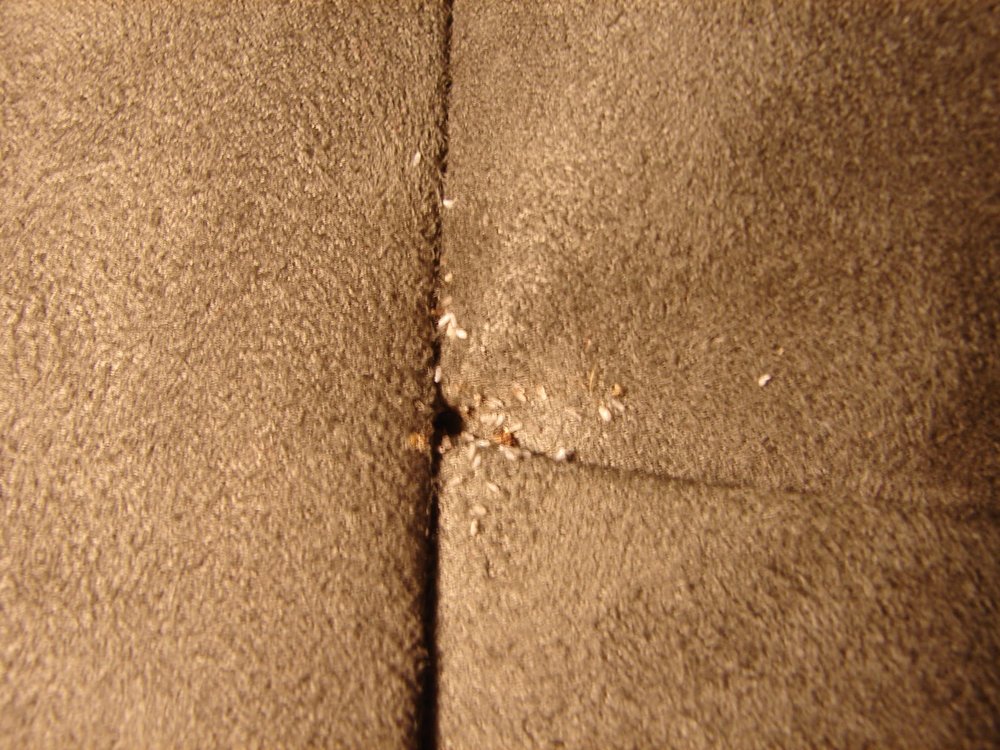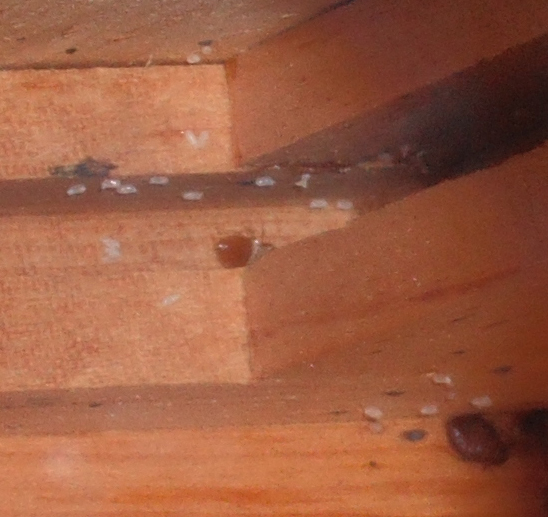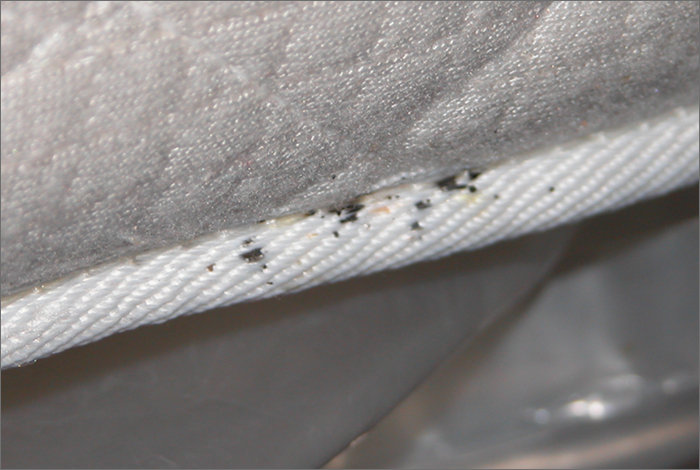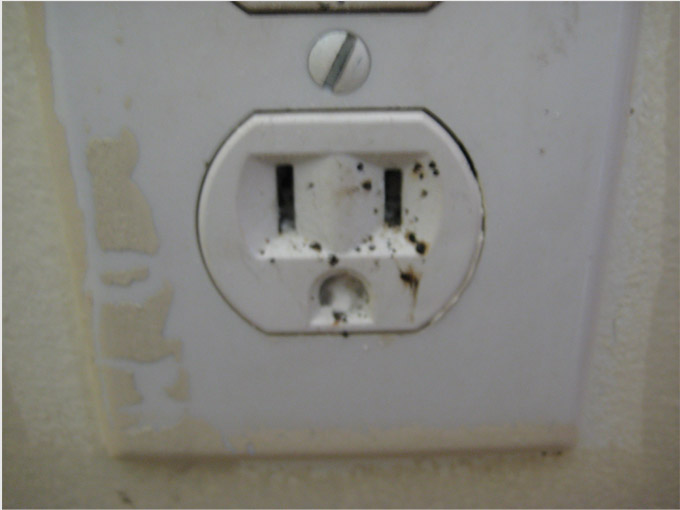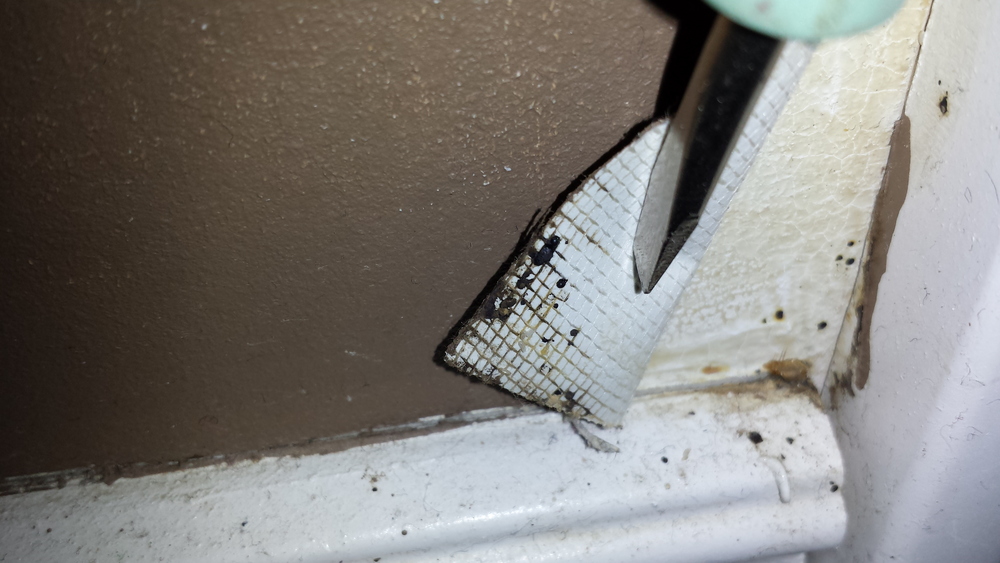Toronto Bedbug Exterminator
Questions and Answers
Knowledge is power.
Don't be fooled by bedbug myths and internet scams. Trust Addison to answer all your bedbug extermination questions.
If you suspect you or someone you know may have a bed bug infestation, there are many questions you need answered.
Information is a powerful tool against bed bugs.
The more you know, the better you can make an informed decision about treatment programs and prevention techniques.
How do I prevent and monitor bed bugs in the Greater Toronto Area?
A few simple techniques for the average person to prevent and monitor bed bugs in your home.
Regular bed bug visual inspections
If you know what to look for, a thorough visual inspection is the most reliable way to spot a bed bug infestation even in its earliest stages.
Bed bugs can be very stealthy pests.
Spotting the early warning signs of an infestation often takes the experienced eye of a professional pest control professional.
Call us to book an inspection service, we can almost always get there the same day.
What you'll need to do a bed bug inspection:
flashlight
small spray bottle
magnifying glass
Latex gloves
Where to look for bed bugs:
Any furniture where you sit, sleep or rest for more than 45 minutes per day
Bed bugs CANNOT penetrate fabrics. They cannot live INSIDE of a mattress or pillow
The less clutter and storage underneath and around the beds couches and chairs the more thorough and conclusive an inspection can be
How to Inspect for Bed Bugs:
Use Your flashlight to look carefully at every surface on, or close to, furniture where you spend 45+ minutes per day sitting, sleeping or resting
Focus especially on cracks, folds, seams and corners
You will need to prop up your mattress and box spring and flip over your couches and chairs
Make sure you check the surface and seams of all of these pieces of furniture:
the sides and bottoms of the mattress
the sides and bottoms of box springs (always pull off the dust cover on the bottom, and check the plastic cups at the corners)
bed slats
bed frame
headboard
the underside, cracks and drawer tracks of side tables
all items in storage bins or drawers underneath the bed
folds of the bed skirt
baseboards around the bed
electrical sockets around the bed
picture frames hanging above the bed
curtains close to the bed
couches
lazy-boys
office chairs
any piece of furniture within 4 feet of beds or couches
What you're looking for:
1. Bed Bug Faecal Markings
Round dark rusty-brown dots about the size of a pinhead in clusters
Bed bug faeces is dried blood
If you wet these spots with your spray bottle and rub them with your finger they will leave a smear marking
2. Bed Bug Eggs
Glassy white and oblong in shape
Often clustered together in a protected area close to the bed or couch surface
Bed bug eggs hatch within 10-14 days
3. Bed Bug Nymphal Skins
wispy exoskeleton casing
light tan translucent colour
4. Bed Bug Nymphs
Nymphs are smaller and lighter in colour than adult bed bugs
They can be smaller than one millimetre about the size of a grain of salt
If nymphs have fed they have a dark red dot in their interior
5. Live Adult Bed Bugs
Adult bed bugs are the size and shape of an apple seed
An oblong abdomen that narrows towards their back end
Bed bugs have a single pair of antennae and a pair of wing pads.
They have a series of horizontal segments along their dorsum that will expand when they are full of blood
Book a professional Pest Control Inspection in the Greater Toronto Area with Addison:
2. Furniture Leg Interceptor Traps
An effective method of monitoring for bed bugs is using interceptors traps also known as passive pitfall traps.
These traps can be filled with mineral oil or diatemaceous earth
Bed bugs may hide directly on the bed or in a crack or crevice nearby the bed
How to monitor bed bugs using interceptor traps
You must set up your bed as an “island": the only thing making contact with the ground is the bed legs inside the interceptor traps
Be very careful to eliminate other pathways for bugs to access the bed:
The bed should not be touching a wall or side table
infested clothing or linens should not be deposited directly onto the bed
Sheets and linens should not hang down from the side of the bed and make contact with the floor
3. Preventative Insecticide Treatment
If you are at high risk of a bed bug infestation you may opt to perform a preventative bed bug treatment.
You should consider a preventative insecticide treatment if:
You live in a Toronto-area building that is repeatedly dealing with bed bug issues
A close friend or family member has been dealing with a bed bug infestation infestation
An adjacent neighbour has a confirmed bed bug infestation
A personal care worker or anyone who visits your home regularly has a confirmed bed bug infestation
Addison's preventative bed bug treatment can keep you protected from bed bug infestation for up to 6 months.
Learn about Addison’s Bed Bug Treatment Process
4. Mattress Encasements
Zip-up mattress encasements are a useful monitoring tool, but they will not prevent bed bugs from infesting your home.
These zip-up covers are useful for spotting bed bug infestations in the early stages
By sealing off the folds and cavities of a typical bed and box spring bed bugs have fewer hiding places
The white surface makes it easier to spot blood spots and bed bug faecal markings
We do not advise customers to put on an encasement AFTER an infestation has been identified. This will not eliminate the bed bug problem
Encasements can rip and tear easily giving bed bugs MORE places to hide out of sight
How do Bed Bugs get into my Toronto-area home?
There are a few different ways that bed bugs may enter a home. It is important to narrow down the source of an infestation so that you are not at risk of having new infesting bugs reintroduced into your home after we have performed a treatment.
1. Picked up in public
Bed bugs can be dropped off in any public place by someone with a severe infestation in their home.
Contracting bed bugs this way is a simple stroke of bad luck, but it means that a single treatment will eliminate the bugs in your home and keep you protected going forward.
Bed Bugs’ favourite nest locations are:
within 3 feet of a sleeping or sitting surface
Secluded
Dark
Immobile
Protected
Individuals may be in danger of transporting a live bug or egg to a public place when they have a severe infestation in their home, especially if they store their clothing or other belongings in drawers or bins underneath their bed or couch.
An infested individual may deposit a bed bug or egg onto any surface in a public place around Toronto or areas you’ve traveled to/from, such as:
the TTC, GO Transit, Taxi Cab, Uber, Lyft
A public library, lecture hall, movie theatre, airport, hospital
A hotel, motel or hostel, AirBnB,
If you have the misfortune of carrying that specimen back to your home, it could be the beginning of an infestation
If you only transport a single male or a single unfertilized female to your home, that bug may feed a few times but will never have the chance to mate and establish subsequent generations.
If, however, you transport a male and a female, a single fertilized female or a couple of eggs, these may be able to mate, breed new generations and establish an infestation in your home.
2. Frequent Visitor
If you have a frequent visitor to your home such as a friend or family member, a caregiver, a cleaner, a tutor or a coworker they may be unknowingly spreading an infestation to your home.
If you find a bed bug in your home, it is important that a professional inspection is performed in the homes of all frequent visitors. Unless these outside sources are identified, you may be at risk of new bugs traveling to your home and constantly resupplying the infestation with new bed bugs.
VERY IMPORTANT:
Bed bug “bites” are an allergic skin reaction to the anticoagulant and anaesthetic agents in bed bug saliva
About 30% of people are not allergic to bed bug saliva
Therefore 1 in 3 people shows NO skin reaction when bed bugs draw their blood
Even if a frequent visitor is not getting bites, it DOES NOT mean that they are in the clear
Most people assume that if they are not getting any bites on their skin, they wouldn't have any reason to suspect they have a bed bug infestation in their home.
After discovering an infestation in your home, it is important to arrange an inspection in the home of any frequent visitor that may be reintroducing live bugs or eggs into your home.
The residual protection of an effective bed bug treatment will continue to kill bugs brought into your home, but after the treatment wears off, you may be at risk of reinfestation from this visitor.
3. Through the Walls
One of the most frequent vectors of infestation is live bugs spreading through the dividing walls of adjacent condo and apartment units, townhouses or a semi-detached home.
Bed bugs live on beds, mattresses, box springs, bed frames, couches, chairs, etc.
Bed bugs do not live within the structure of a building like cockroaches, mice or rats.
Bed bugs feed on mammalian blood to survive and will therefore establish their hiding spots as close as possible to sleeping and resting surfaces within the home.
Scientific explanations differ for when, how, why and how far bed bugs will wander from unit to unit in a building. Here are three theories that contribute to answering this question
Pheromones
Bed bugs communicate by excreting pheromones through their faeces.
The pheromone in low concentrations tells other bugs in the immediate vicinity that a suitable hiding spot has been found.
Attracted by the pheromone and bodily contact with other bugs, bed bugs tend to form clusters in these nesting sites
In higher concentrations, this pheromone acts as a deterrent and may be a factor that causes new bugs to wander away from their nest sites.
This means that when an infestation has become severe within a unit, the deterrent pheromone may cause bugs to wander far away from the original nest and find their way into adjacent units.
Carbon Dioxide, Heat and Darkness
Bed bugs are drawn to carbon dioxide, heat and darkness. Their antenna contain sophisticated sensory organs that can pick up on these three attractants from up to 12 feet away
Host Departure
A scenario we encounter quite frequently is when someone is suffering from a bedbug infestation they may be so horrified that they leave their apartment or home to stay at a relative’s, friend’s or a hotel.
When the host departs bed bugs will begin to wander through the walls, vents or halls to try to find a new host to feed on
Store Bought Insecticides
Many store bought insecticides can cause bed bugs to disperse and can be harmful to your health if used improperly or excessively.
Rather than residual insecticides that remain active on surfaces for an extended period of time and kill bugs as they walk over those surfaces, most commercially available products are contact killers only.
These products can cause bed bugs to wander away from their original nest locations and find their way into uncommon hiding spots or even into adjacent units or attached houses.
If bed bugs entered your home this way, you will need to notify neighbours, landlords, property management companies, superintendents etc.
Getting all these parties involved can be complicated and awkward
Many people don't want to speak openly about bed bugs because of the stigma surrounding this pest.
We have decades of experience in mediating these encounters, and in our experience, the best policy is always openness and honesty paired with thoroughness and professionalism.
Luckily you have already done the right thing by contacting Addison. We can help you deal with any complexities and issues around communicating with neighbours and landlords.
4. Used Furniture or Clothing
Another common way that bed bugs get into your home is buying or finding used furniture or clothing
Mattresses discarded at the side of the road should be properly wrapped and marked if they are infested with bed bugs.
Unfortunately, this guideline is often neglected, and items are collected without knowing they are infested.
Couches and chairs bought from classified websites such as Craigslist or Kijiji may be infested with bed bugs without the knowledge of the seller.
How do I know if I have bed bugs?
You know you have a bed bug infestation if:
you are either getting bed bug bites
you see bed bug fecal matter
you see live bed bugs or bed bug nymphs
you see bed bug eggs or bed bug shed skins
Check out our Bed Bug Inspection Page for in-depth walk through of how to look for bed bugs in your home.
Sighting one single bed bug or even a single fecal marking should be taken very seriously, and usually means that you should arrange a professional pest control treatment as soon as possible.
Bed bugs are very stealthy pests so if you spot a single bug it means there are likely many more that you cannot see.
VERY IMPORTANT:
Bed bug bites are a skin reaction to the anticoagulant and anesthetic agents the bug injects as it’s drawing blood.
About 30% of people do not react to bed bug bites.
Even if you are NOT getting bites you still may have a bed bug infestation.
Bed bugs leave distinctive visual markings of their presence.
What to do if I found a bed bug in my home?
If you have found a bed bug in your home do not panic. You have come to the right place.
Sighting one single bed bug or even a single fecal marking should be taken very seriously, and usually means that you should arrange a professional pest control treatment as soon as possible.
Bed bugs are very stealthy pests so if you spot a single bug it means there are likely many more that you cannot see.
Finding a single bug or a single fecal marking usually means that it is time to take action.
All too often we have seen customers that choose to wait it out, try home remedies, or just hope for the best. Unfortunately bed bugs never go away on their own, and store bought methods are dangerous and ineffective.
Bed bug infestations can escalate very quickly. A single female can produce over 200 offspring in her lifetime and every new generation comes into being in the space of six to eight weeks.
Once infestations enter the second or third generation it can be a much bigger challenge to address the issue, and you may run the risk of spreading the infestation to the homes of loved ones or to neighbouring apartments, condo units or houses.
How do I prepare for a bed bug treatment?
There is a common misconception that preparation for bed bug treatment is extensive and labour intensive.
At Addison we do not require you to do extensive preparation, laundry, bagging or discarding.
Preparation for Addison’s bed bug remediation is only a few easy steps:
Step 1: Clean Up
Remove all bedding from mattresses including covers, sheets, pillows, mattress covers, pillow-top covers, etc., and place in sealed garbage bags until they can be laundered.
Gather any dirty clothing from the floors or hamper and place in sealed garbage bags until it can be laundered.
Temporarily empty the contents from drawers of dressers or cabinets immediately next to the beds.
Bag, seal, and throw out any garbage from the floor around and under the bed.
Clear out storage bins or drawers underneath the bed and prepare them to be treated
Step 2: Laundry
Launder any clothes or linens that you store within three feet of the bed on a HOT wash and a HOT dry cycle. This laundry should be done within a few days of the treatment.
Any items that are not machine-washable (pillows, duvet, stuffed animals, slippers, etc) should be put through the dryer on high heat for a minimum of 30 min.
Any items that are not dryer friendly can be taken to the dry cleaner.
Step 3: Vacating and re-entering the premises
Occupants should plan to be out of the house for 4-5 hours while we perform the bed bug extermination.
Pets: The treatment is safe for pets. All pets should vacate the home for the same time period as people.
Cats: should be out of the treated area for a full 24 hours.
Aquariums should be covered with plastic sheets or bags.
Windows can be opened or closed.
It is perfectly safe to sleep in your bed the very same night.
Step 4: Follow-Up and Prevention
Do NOT wet mop the floors or shampoo the carpets for 3 months as this will wash away the residual insecticide and cancel the protection it offers.
Sweeping, vacuuming, and cleaning up spills is OK - wiping the cooking area, bathroom, entryway, etc is OK - but you must avoid washing floors in the key areas, such as the bedrooms and the living rooms particularly around the beds, couches, and chairs.
Launder your bedding once a week until the infestation is eradicated.
Inspect your mattress, box spring, bed frame, headboard, and areas surrounding the bed and seating furniture regularly for signs of bed bugs.
Do NOT use any store-bought bug spray or powder. This could counteract the high-quality residual insecticide we use as part of our treatment
Do NOT use a zip-up mattress encasement after we have treated your bed, mattress, and box spring. By zipping an untreated encasement around your mattress after the treatment has been applied you are introducing an untreated surface into the bed area that the bugs may be able to freely infest.
Do NOT Throw out your bed, box spring, mattress, couch, clothing or other infested furniture or fabrics. If you throw out your bed and get a new one it will not have the treatment on it and could be a place that bugs hidden in your apartment are free to infest.
Can I get rid of bed bugs on my own?
Any level of bed bug infestation should be handled by licensed pest control professionals. We have seen so many cases of homeowners battling against bed bugs for months or years with home remedies that only ever endanger your health, risk spreading the infestation and breed pesticide resistance in a persistent bed bug population.
In addition to a professional bed bug treatment however there are some things you can do right away to get rid of bed bugs in the home.
1. Squish!
Manually kill as many bed bugs as you can find around your beds and couches before we come to apply the bed bug treatment
Every bug you kill is a bug that can no longer bite or reproduce.
Use a damp cloth or paper towel and wipe them up
be sure to squeeze them with enough pressure to kill them
If they have had a recent blood meal they may leave a blood mark on the towel
Dispose of these bugs in a sealed bag
2) Heat
High temperatures are very effective for killing bed bugs at all stages of their life cycle. The lethal temperature for bedbugs is between 50ºC-60ºC (approx 120ºF-140ºF).
Heat can be applied in a number of ways:
Laundry
Anything on, under, or within three feet of the bed that can be washed should be laundered on a HOT wash and a HOT dry cycle.
If an item cannot be washed but can be put through the dryer, the heat from an extended dryer cycle on the high heat setting is sure to kill any bug or egg present, this method is effective for treating items like quilts, stuffed animals, slippers, shoes, bags, etc.
Steam
Handheld steamers are somewhat effective for killing live bugs and eggs.
The hot steam will kill anything it comes into contact with.
Unfortunately steaming alone is almost never sufficient, you will need other methods to kill bugs and eggs hiding in areas you cannot access with the steaming head.
Heaters
Turning up your thermostat or space heaters will not produce enough heat to kill bed bugs and eggs.
Even if you can get the ambient temperature up very high, you cannot be certain of the temperature inside wall voids, underneath beds, or in a back corner far away from the heater or heating vent.
Beware of companies that advertise a bed bug service that heats your entire home up to the lethal temperature for bed bugs. These whole-house heating techniques are very expensive, can cause extensive damage to furniture and art, and can cause bed bugs to spread through the walls to adjacent homes or apartment units.
3) Cold
Cold temperature is also an effective way to kill bed bugs. There is much debate among entomologists as to the necessary temperature and length of time necessary to freeze and kill all bed bugs and eggs present. Anecdotal evidence has shown that a few days in freezing cold temperatures will indeed kill bugs and eggs. A few different methods for applying cold.
Winter & Outdoors
In climates where winter temperatures reach well below the freezing point, placing boxes or bags of items outdoors in a freezing cold garage, porch or balcony is an economical way to sanitize these items of bed bugs and eggs.
Deep Freezer
Items should be frozen for at least 2 days. The longer the better.
another home remedy is to place items in your refrigerator’s freezer or chest style deep freezer.
4) Vacuuming
Sucking up bed bugs in a vacuum is a quick way to get them off your bed. Be sure to empty the vacuum contents into a sealed bag and treat the inside of the vacuum with a powder insecticide.
Vacuuming is not effective for picking up bed bug eggs because bed bugs cement their eggs to the surface on which they are laid.
5) Throwing Out Furniture and Belongings
Bed bugs are just as likely to hide around the bed as they are to be on a mattress, box spring, or bed frame.
Throwing out items will eliminate any live bugs and eggs contained within those items from your home. However, it can be an expensive and often unnecessary task. Items can be salvaged if they are treated with a residual insecticide.
DO NOT throw out your bed or box spring after we have treated your home. If you replace furniture after we have applied treatment to it, you are introducing untreated items into the infested area and bed bugs can freely infest these untreated surfaces.
6) Store-Bought Insecticides
The insecticides that we use at Addison are not available to the wider public. The products we use are the highest quality, safest, and longest acting available on the market that are only available to fully licensed
and insured pest control companies.
All too often we have encountered customers who have used store-bought insecticides, bug bombs, or powders such as RAID, or diatomaceous earth. These control methods are never successful in eliminating a bed bug infestation.
These products can cause bed bugs to spread unpredictably, can endanger your health, and will eventually establish pesticide resistance in the bug population in your home.
In order to effectively address a bed bug infestation, it is important that a licensed pest control company uses high-quality, long residual insecticides applied in the proper concentration to the infested surfaces.
ANY other method could cause bed bugs to establish pesticide resistance and will end up causing escalating expense, persistent infestations, emotional distress, constant sleep deprivation, and frustrating re-infestation.
If you’re looking for an exterminator in St. Catharines, contact us today!
Additional Bed Bug FAQs
Q: Are bed bugs real?
A: Yes. Many people recall bed bugs from the bedtime rhyme “good night, sleep tight, don’t let the bed bugs bite” and assume they are fictional and used to scare small children. Bed bugs are certainly very real and are making a worldwide resurgence after being nearly eliminated as the common household problem they were in the early – mid 1900’s.
Q: What are bed bugs?
A: Bed bugs are small insects that feed on human blood. They are usually active at night when people are sleeping.
Q: Are bed bugs big enough to see?
A: Yes. Adult bed bugs have flat, rusty-red-coloured oval bodies that resemble an apple seed in size, shape and colour, easily seen with the naked eye. However, they are adept at hiding and are most often hidden away in cracks, crevices, screw holes or other places on or around the bed frame, baseboards and surrounding furniture and clutter. It can be very difficult to see or find a bed bug when it is hiding.
Q: Do bed bugs live in the mattress?
A: Bed bugs can live in a mattress but contrary to popular belief, they are not tiny mite-sized creaters that permeate the fabric and paddingon the top of the mattress – they cannot travel through fabric but rather crawl on and around it. Bed bugs can travel through rips or holes in a mattress so it is possible for the bugs to live inside mattresses and box springs. It is far more common that bed bugs live along the folds and seams of a mattress’s exterior – or in cracks and holes in the bed frame or surrounding baseboards, flooring and furniture.
Q: What does a bed bug bite feel and look like?
A: Most bed bug bites are initially painless, but later turn into large, itchy skin welts. These welts do not have a red spot in the center like flea bites. HOWEVER, some people do not react at all to bed bug bites – that is, they are indeed getting bitten at night but do not develop any sign, redness, itchiness, swelling or otherwise. Some entomologists say up to 30% of the population does not react to bites. We, at Addison, feel this is contributing significantly to the spread of bed bugs – people who show no signs of bites often have the worst infestations because they have no reason for concern and do not realize they have bed bugs – and that they are spreading the bugs to friends, family, co-workers, neighbours, etc.
Q: Are bed bugs dangerous?
A: Although bed bugs are a nuisance, they are not known to spread disease.
Q: How does a home become infested with bed bugs?
A: In most cases, people carry bed bugs into their homes unknowingly, in infested luggage, furniture, bedding, or clothing. Bed bugs may also travel between apartments through small crevices and cracks in walls and floors.
Q: How do I know if my home is infested with bed bugs?
A: You may notice itchy skin welts. You may also see the bed bugs themselves, small bloodstains from crushed insects, or dark spots from their droppings. It is often hard to see them because they hide in or near beds, other furniture, and in cracks.
Q: How can I get rid of bed bugs?
A: The City of Toronto recommends hiring a pest control professional licensed by the Ontario Ministry of the Environment to get rid of bed bugs. Unlicensed exterminators are working illegally, have no insurance and do not have access to purchase the effective pesticides necessary to eliminate bed bugs – purchasing professional-grade pesticides requires a valid license in Ontario. There are many home remedies, DIY solutions and consumer-grade products described on the internet and found in hardware stores – these are generally ineffective compared to the professional-grade products available to licensed exterminators and almost entirely ineffective against severe infestations.
Q: Is it necessary to use insecticides to get rid of bed bugs?
A: There are many non-toxic do-it-yourself techniques and non-toxic consumer-grade products that are effective for killing individual bugs – however, they are not adequate for elimination of an established infestation. They are not pervasive enough to reach and kill all bed bugs living in a dwelling. Residual insecticides that stay active for weeks at a time are a necessary component for eliminating bed bugs completely because they will continue to affect any bugs that come out of their hiding places at a time long after the exterminator visit.
What A Happy Client Says About Addison Pest Control on Google
I am thrilled with the service Addison provided in a recent Bedbug treatment. It is surprising to find good customer service nowadays and cannot say enough good things about them. Jay was fantastic, answering all my questions and providing additional information to give me a very clear idea of what to expect throughout the process both during and after the treatment. I booked a visual inspection first followed with a treatment. They had an earlier opening and they were able to move our appointment up which I really appreciated. Robbie was absolutely amazing, he was very friendly and helpful. He went above and beyond and I am very appreciative. I am very thankful to Addison, it wasn’t a pleasant experience to find the pest but they truly made the best of a very unfortunate situation.
Catalina M.
⭐⭐⭐⭐⭐
We’re Proud of our 4.9/5 Rating Across 1225+ reviews on Google






